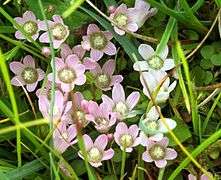Anagallis tenella
Anagallis tenella, known in Britain as the bog pimpernel,[1] is a low growing perennial plant found in a variety of damp habitats from calcareous dune slacks to boggy and peaty heaths in Eurasia. In the United Kingdom it is mostly restricted to the western half of the country, although it was more common in the east before land drainage and intensification of farming in that area.[2]
| Bog pimpernel | |
|---|---|
 | |
| Scientific classification | |
| Kingdom: | Plantae |
| Clade: | Tracheophytes |
| Clade: | Angiosperms |
| Clade: | Eudicots |
| Clade: | Asterids |
| Order: | Ericales |
| Family: | Primulaceae |
| Genus: | Anagallis |
| Species: | A. tenella |
| Binomial name | |
| Anagallis tenella | |
Traditionally included in the family Primulaceae, the genus Anagallis was considered to be better placed within the related family Myrsinaceae.[3] In the APG III system, Primulaceae is expanded to include Myrsinacae, thus Anagallis is now in Primulaceae again.
In England this plant is a component of the Purple moor grass and rush pastures BAP habitat.
References
- "BSBI List 2007". Botanical Society of Britain and Ireland. Archived from the original (xls) on 25 January 2015. Retrieved 17 October 2014.
- Preston, C.D.; Pearman, D.A.; Dines, T.D., eds. (2002). New Atlas of the British and Irish Flora: An Atlas of the Vascular Plants of Britain, Ireland, The Isle of Man and the Channel Islands. Oxford University Press. ISBN 0198510675.
- Källersjö, Mari; Bergqvist, Gullevi; Anderberg, Arne A. (2000). "Generic realignment in primuloid families of the Ericales s.l.: a phylogenetic analysis based on DNA sequences from three chloroplast genes and morphology". American Journal of Botany. American Journal of Botany, Vol. 87, No. 9. 87 (9): 1325–1341. doi:10.2307/2656725. JSTOR 2656725. PMID 10991903. (full pdf.text)
Sources
- Stace, Clive (2010). New Flora of the British Isles. Cambridge University Press. ISBN 0521707722.
- Manns, Ulrika; Anderberg, Arne A. (2005). "Molecular Phylogeny of Anagallis (Primulaceae) Based on ITS, trnL-F, and ndhF Sequence Data". International Journal of Plant Sciences. 166 (6): 1019–1028. doi:10.1086/449318.
This article is issued from Wikipedia. The text is licensed under Creative Commons - Attribution - Sharealike. Additional terms may apply for the media files.